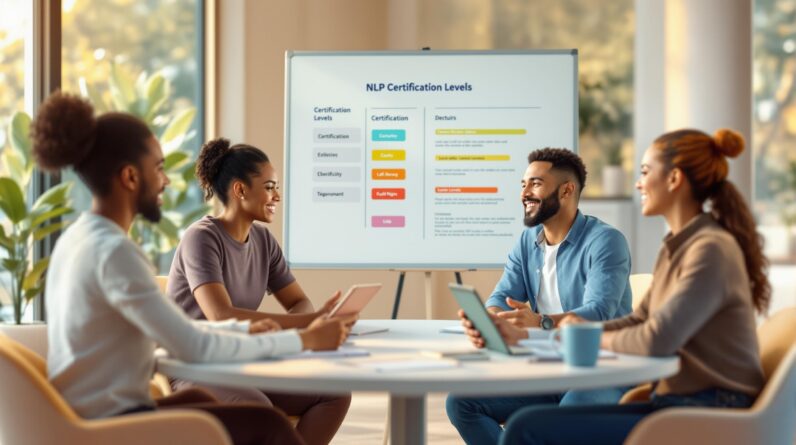
NLP (Neuro-Linguistic Programming) certifications are structured into four main levels, each building on the previous one to develop specific skills in communication, behavior, and personal growth. Here’s a quick breakdown:
- Practitioner Certification: Learn core NLP techniques like rapport building, anchoring, and reframing. No prior experience needed. Duration: 7–25 days. Applications include coaching, therapy, and business communication.
- Master Practitioner Certification: Advanced methods like meta-programming and values-level thinking. Requires Practitioner certification. Duration: 9–20 days. Focuses on handling complex cases and leadership roles.
- Trainer Certification: Prepares you to teach NLP. Includes teaching methods, live demonstrations, and evaluations. Requires Master Practitioner certification.
- Master Trainer Certification: The highest level. Emphasizes leadership, mentorship, and developing new NLP models. Requires years of training experience.
Quick Comparison
| Level | Focus | Duration | Entry Requirements |
|---|---|---|---|
| Practitioner | Core NLP techniques | 7–25 days | None |
| Master Practitioner | Advanced NLP methods | 9–20 days | Practitioner Certification |
| Trainer | Teaching and mentoring skills | 15–20 days | Master Practitioner Certification |
| Master Trainer | Leadership and community contribution | 6–12 months | Trainer Certification + Experience |
Each level offers specific skills and career opportunities, from personal development to corporate training and independent coaching. Choose the certification based on your goals, training format preference (online or in-person), and budget. Always ensure the program is accredited by recognized organizations like ABNLP or INLPTA.
The 4 Levels of NLP Trainings
NLP Practitioner Certification
NLP Practitioner certification is the starting point for those diving into Neuro-Linguistic Programming. It’s designed to teach the core techniques and methods that form the foundation of NLP.
Course Topics and Skills
The NLP Practitioner program focuses on key techniques that are essential for NLP practice, including:
- Rapport Building: Develop advanced communication skills to create strong, meaningful connections.
- Anchoring: Learn how to link specific triggers to desired emotional states.
- Reframing: Practice shifting perspectives to change how situations are perceived.
- Sensory Acuity: Improve your ability to observe and interpret subtle communication cues.
The American Board of NLP (ABNLP) sets a requirement of at least 120 hours of training on these core areas [1], ensuring participants gain both a solid understanding and hands-on experience.
Entry Requirements and Duration
No prior experience in NLP is needed to enroll in a Practitioner program [1]. These programs typically run for 7-25 days and are offered in various formats: intensive in-person workshops, hybrid courses blending self-study with live sessions, or fully online options for added flexibility.
Applications and Career Options
The skills learned in an NLP Practitioner course can be applied in various professional fields, such as:
- Coaching: Use NLP tools to support personal development and life coaching.
- Business Communication: Strengthen workplace communication and improve team dynamics.
- Therapy: Complement existing therapeutic practices with NLP techniques.
- Marketing: Leverage psychological principles to enhance communication strategies.
This training aligns with the increasing demand for NLP expertise highlighted earlier [2][4].
NLP Master Practitioner Certification
The Master Practitioner certification takes NLP skills to the next level, focusing on deeper cognitive patterns and advanced interventions. It builds on the foundation laid at the Practitioner level, offering a more comprehensive set of tools for practitioners.
Advanced Techniques and Curriculum
This program introduces advanced methodologies that refine and expand existing skills:
- Meta-programming: Goes beyond basic reframing to address the core thinking patterns behind behavior.
- Values Level Thinking: Targets core motivations, enhancing communication strategies learned at the Practitioner level.
- Advanced Timeline Techniques: Tackles complex temporal patterns to resolve deeply rooted issues.
Students apply these concepts in real-world scenarios, demonstrating their abilities in full coaching sessions with peers.
Eligibility and Training Structure
To join a Master Practitioner program, participants must already hold an NLP Practitioner certification [1]. The training is more rigorous than the Practitioner level and typically includes:
| Training Components | Duration | Format |
|---|---|---|
| Classroom Learning | 9–20 days | In-person or virtual |
| Home Study | Variable | Self-paced |
| Practical Sessions | Multiple | One-on-one coaching |
This structure blends theoretical learning with hands-on practice [1].
Career Opportunities
While the Practitioner certification paves the way for entry-level roles, the Master Practitioner credential prepares professionals to:
- Work with more challenging client cases.
- Develop corporate training programs.
- Lead change initiatives within organizations.
With these advanced skills, practitioners can also establish independent coaching businesses and position themselves as leaders in their field [1][2].
NLP Trainer Certification
The Trainer certification builds on the skills of a Master Practitioner, shifting the focus toward educational leadership. These programs emphasize both teaching techniques and advanced NLP applications.
Trainer Course Structure
| Component | Duration | Focus Areas |
|---|---|---|
| Teaching Methodology | 3-5 days | Presentation techniques, group dynamics, learning styles |
| Advanced NLP Training | 4-8 days | In-depth pattern work, intervention methods |
| Evaluation Phase | 2-3 days | Live demonstrations, assessments |
| Teaching Practice | 4-5 days | Delivering live instruction |
The American Board of NLP (ABNLP) requires at least 120 hours of training on fundamental NLP patterns, taught by certified trainers [1].
Trainer Responsibilities
Trainers play a key role in creating programs, mentoring students, and ensuring certification standards are met through hands-on evaluations. Their responsibilities include:
- Workshop Facilitation: Designing and delivering NLP training sessions.
- Student Development: Offering personalized feedback and support during the certification journey.
- Quality Assurance: Upholding training standards and assessing student performance in line with certification requirements.
- Community Building: Contributing to the wider NLP community through research and the development of practices.
The Association for NLP (ANLP) highlights the need for clear evaluation criteria to track student progress effectively [3].
Professional Opportunities
Trainers, like Master Practitioners, can make an impact in various professional areas:
- Corporate Training: Designing and implementing programs to enhance employee skills.
- Private Practice: Many trainers run independent businesses, offering certifications and specialized workshops [1][3].
- Mentorship Programs: Experienced trainers often mentor new NLP practitioners, adding revenue through coaching and supervision services.
sbb-itb-d87b7ee
NLP Master Trainer Certification
The Master Trainer certification is the pinnacle of NLP expertise, emphasizing leadership and community involvement. It builds on the Trainer Certification while upholding the high standards set by previous levels.
Leadership and Mentorship
To qualify, candidates must hold Master Practitioner credentials and have 3-5 years of verified training experience. Master Trainers play a key role in advancing NLP by:
- Mentoring trainers and practitioners
- Establishing and upholding certification standards
- Organizing conferences and spearheading research projects
- Guiding the next wave of NLP professionals
Training and Evaluation
Becoming a Master Trainer involves meeting demanding requirements, including:
- 40-60 hours of live demonstrations
- A 6-12 month research project
- Over 100 hours of supervised mentorship
The American Board of NLP (ABNLP) enforces these rigorous evaluation criteria [1].
Contributions to NLP
Master Trainers go beyond teaching – they actively shape the field by:
- Developing and validating new NLP models
- Creating advanced training programs
- Integrating NLP with fields like psychology, education, and business
The Association for NLP (ANLP) highlights the critical role Master Trainers play in maintaining ethical practices and high standards across the NLP community [3].
Choosing an NLP Certification
Selecting the right NLP certification program depends on three main factors: your goals, the training format, and accreditation.
Key Considerations
Your career goals play a big role in deciding which certification to pursue. For those aiming to become NLP coaches, the Master Practitioner certification is a better fit. If you’re focusing on personal growth, the Practitioner level may be enough.
The time commitment increases with certification levels. Practitioner programs typically last 7-12 days, while Master Practitioner courses range from 9-20 days [1][2]. Costs also rise with advanced certifications. Practitioner programs start at $790, but higher-level certifications involve greater financial commitments [4]. When budgeting, remember to include course fees, materials, and travel expenses.
These considerations tie directly to the career paths discussed in earlier certification levels.
Online vs. In-Person Training
When deciding between online and in-person training, consider the following differences:
| Aspect | Online Training | In-Person Training |
|---|---|---|
| Flexibility | Learn at your own pace from anywhere | Fixed schedule and location |
| Interaction | Virtual sessions and digital tools | Hands-on experience and direct feedback |
| Cost | Lower overall, no travel required | Higher, includes travel costs |
| Learning Style | Ideal for independent learners | Better for those who prefer guided learning |
| Networking | Limited peer engagement | Stronger connections with fellow participants |
Accreditation and Recertification
Ensure your chosen program is accredited by organizations like ABNLP or INLPTA for global recognition. Accreditation from ABNLP or ANLP also means you’ll need to complete CPD hours for recertification, keeping you aligned with industry standards [1][3].
Conclusion
NLP certification offers a clear path for developing skills, starting with basic techniques at the Practitioner level and progressing to leadership roles as a Master Trainer. Each certification stage builds on the previous one, opening doors to new professional opportunities while adhering to the organizational standards mentioned earlier.
Advanced certifications, like Master Practitioner and beyond, equip individuals to handle complex interventions and take on leadership positions. These qualifications are particularly useful in areas such as coaching, therapy, business communication, and personal development [1][2].
Next Steps
Ready to take the next step? Here’s how you can get started:
- Clarify your goals: Are you looking to master core skills or explore advanced applications?
- Research programs: Look into accredited courses to find the best fit for your needs.
- Check prerequisites: Ensure you meet the requirements for your desired certification level.
For more resources, training reviews, and expert guidance on NLP certifications, check out NLP Yourself. The site provides practical advice on using NLP in everything from workplace communication to personal growth.
FAQs
What’s the difference between an NLP practitioner and a master practitioner?
The main difference lies in the depth of training and expertise. Practitioners focus on foundational skills, while Master Practitioners dive into more advanced techniques and applications.
For example, the ABNLP requires over 120 hours of training for Practitioner certification [1]. Master Practitioner programs go further, introducing advanced concepts like Values Level Thinking and requiring participants to demonstrate coaching skills [1][3]. Training time also differs: Practitioner programs typically last 7-25 days, while Master Practitioner certification involves additional, in-depth training.
This advanced level of training equips professionals to handle more complex client needs and implement specialized techniques. It ensures a clear progression in skills as individuals move through certification levels.
Related Blog Posts
- Steps to Becoming an NLP Master Practitioner
- Comparing NLP Practitioner and Master Practitioner Certifications
- Career Opportunities for NLP Master Practitioners
- Top Free NLP Certification Programs Online







